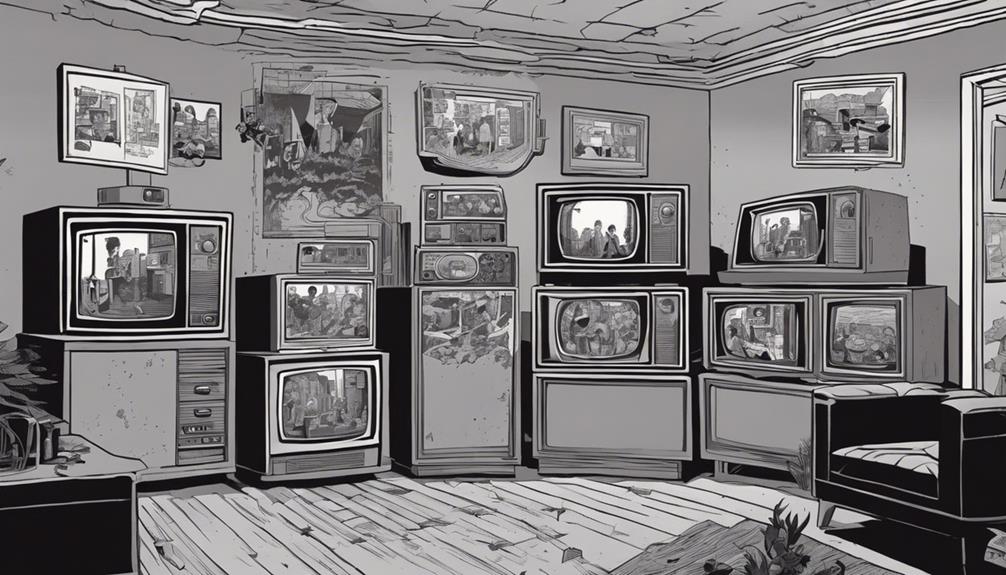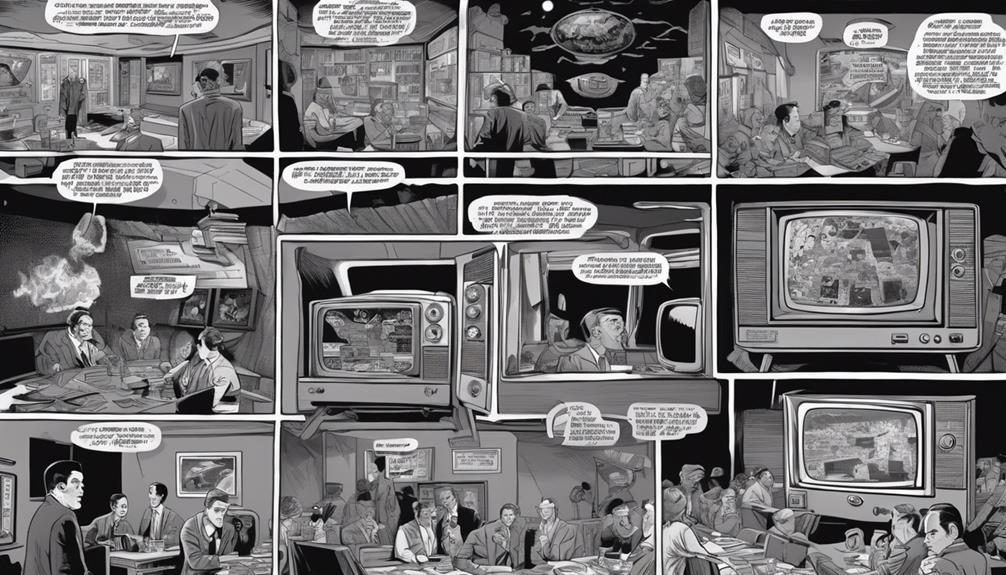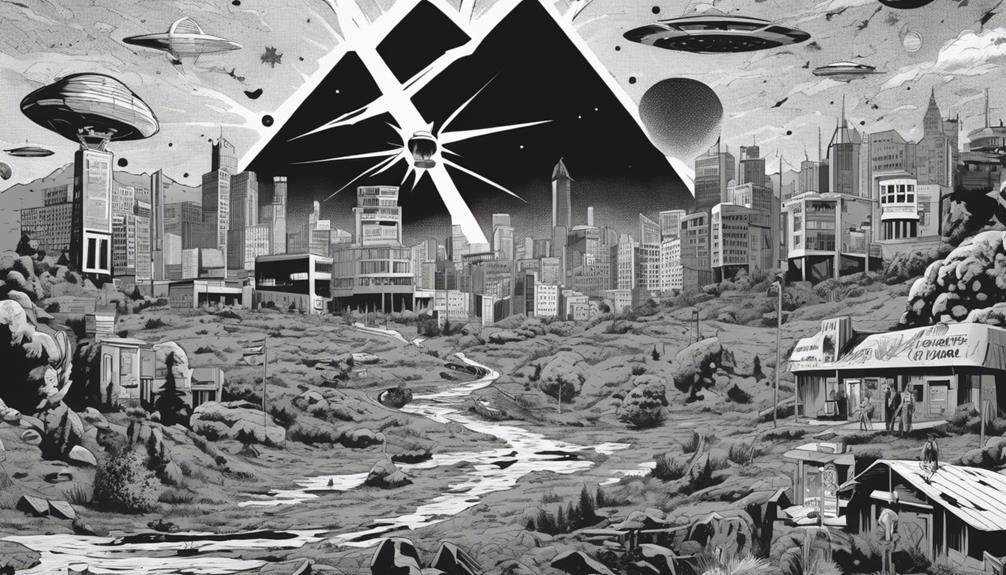We've compiled the top eight Twilight Zone episodes. 'Time Enough at Last' slices through the concept of absolute freedom, while 'The Monsters Are Due on Maple Street' explores the destructive effect of paranoia. 'Walking Distance' is steeped in nostalgia and 'Eye of the Beholder' critiques societal standards of beauty. 'Living Doll' merges horror and social critique, and 'Nightmare at 20,000 Feet' uncovers fear manifestation. 'The Invaders' disrupts perceptions, while 'To Serve Man' cautions against blind trust. Each of these episodes offers a unique, trouble-provoking experience. Stick around to delve into the richness of these masterpieces.
Key Takeaways
- 'Time Enough at Last' ranks highly due to its examination of societal dependence and the double-edged sword of absolute freedom.
- 'The Monsters Are Due on Maple Street' captivates with its intense study of paranoia, fear, and human capacity for self-destruction.
- 'Walking Distance' impresses with its nostalgic portrayal of the protagonist's yearning for simpler times and the impossibility of recapturing the past.
- 'Eye of the Beholder' stands out for its exploration of societal norms, beauty standards, and its potent visual symbolism.
- 'To Serve Man' is notable for its exploration of human trust, deception, and its chilling reminder to question benevolent acts' true intentions.
"Time Enough at Last" Analysis
Diving straight into 'Time Enough at Last', it's apparent that this episode stands out as a poignant exploration of solitude and the human desire for unobstructed leisure time.
We're introduced to the 'Lonely Librarian's Plight' as he yearns for freedom from societal demands to indulge in his passion for reading. In a twist of fate, he gets his wish but at a devastating cost: he's left alone in a post-apocalyptic world.
This leads us to a 'Societal Dependence Analysis'. Despite our grievances with societal expectations, we can't overlook its pivotal role in shaping our experiences and fostering our connections. We're inherently social creatures, and without others, even the seemingly perfect solitude can become an unbearable burden.
Thus, 'Time Enough at Last' serves as a stark reminder of the double-edged sword of absolute freedom.
Diving Into "The Monsters Are Due on Maple Street"

Turning our attention to 'The Monsters Are Due on Maple Street', we find an intense study of paranoia and the destructive power of fear.
The episode brilliantly portrays Maple Street's paranoia, sparked by the perceived threat of alien manipulation. The residents, once friendly neighbors, quickly turn on each other, their trust eroded by suspicion and fear.
The alien manipulation here is subtle, their power lying in psychological warfare rather than direct confrontation. The aliens merely suggest a threat and stand back as the community tears itself apart.
This episode serves as a powerful commentary on the human capacity for self-destruction when faced with fear, making 'The Monsters Are Due on Maple Street' a standout in The Twilight Zone series.
Unpacking "Walking Distance"
Shifting our focus from the paranoia-ridden 'Monsters Are Due on Maple Street', we find ourselves in the nostalgic and introspective realm of 'Walking Distance', another remarkable Twilight Zone episode. This episode significantly showcases the Nostalgia Influence and how it shapes our Reality Perception.
Here, we analyze four crucial elements:
- The protagonist's yearning: An overworked man longs for simpler times, a common sentiment often amplified by nostalgia.
- The town: His childhood town, unchanged, represents the static nature of memory.
- The carousel ride: A symbol of his desire to return to innocence, showing nostalgia's strong allure.
- The climax: His encounter with his younger self and the subsequent injury, underscores the impossibility of truly recapturing the past.
This episode reminds us: nostalgia, while powerful, can distort reality.
The Brilliance of "Eye of the Beholder"

In the realm of 'Eye of the Beholder', we're presented with a brilliant exploration of societal norms and beauty standards, demonstrating Rod Serling's knack for tackling pressing social issues within the framework of a Twilight Zone episode.
The visual symbolism is potent; it's a mirror reflecting society's perception, challenging us to question our own definitions of beauty. We're made to feel discomfort, illustrating the power of Serling's storytelling.
The episode doesn't hold back in its critique of societal obsession with conformity, using its twist ending to drive home the message. We're compelled to acknowledge the arbitrary nature of beauty standards and the dangers of a homogenized society.
Truly, 'Eye of the Beholder' is a masterclass in thought-provoking television.
"Living Doll" Deep Dive
Diving into the eerie depths of 'Living Doll', we find another Serling masterpiece that expertly intertwines fear, suspense, and social commentary.
- The Doll's Sentience is the episode's central plot device, turning an innocent toy into a source of terror.
- The Psychological Horror unfolds as the doll's owner, Erich, grapples with the reality of the talking doll, amplifying the tension.
- Serling's social commentary is unmistakable. He uses the doll, Talky Tina, to critique the destructive dynamics of the nuclear family.
- The episode's climax demonstrates the power of the supernatural over the rational, leaving us pondering the boundaries of reality.
In essence, 'Living Doll' is a potent blend of suspense, fear, and social critique that remains as chilling today as it was during its original airing.
"Nightmare at 20,000 Feet" Examined

Moving from the domestic horror of 'Living Doll', we now turn our attention to the gripping terror of 'Nightmare at 20,000 Feet', another sterling example of Rod Serling's masterful storytelling.
This episode is a powerful exploration of fear manifestation, taking the universal dread of flying and escalating it with uncanny aircraft anomalies. A gremlin sabotages the plane, visible only to one man, who grapples with both his terror and the skepticism of others.
The suspense is palpable, and the narrative masterfully exploits our innate fear of the unknown. It's this, coupled with Serling's insightful commentary on societal disbelief of mental health issues, that elevates 'Nightmare at 20,000 Feet' to one of the Twilight Zone's most potent and enduring entries.
Exploring "The Invaders"

Shifting our focus to 'The Invaders', we're dealing with a quintessential example of the Twilight Zone's knack for turning the everyday into the extraordinary.
- 'Invaders' symbolism: The tiny invaders symbolize fear of the unknown, illustrating how we often perceive ourselves as the center of the universe.
- Alien representation: The episode cleverly subverts our expectations by revealing the 'aliens' as Earth astronauts.
- Narrative twist: The surprise ending forces us to reconsider our role in the larger universe.
- Social commentary: Through the lens of science fiction, the episode critiques human arrogance and xenophobia.
In 'The Invaders', we confront our fears, and in doing so, gain the power to transcend them. This is the Twilight Zone at its best.
"To Serve Man" Episode Breakdown

Turning our attention to 'To Serve Man', this Twilight Zone episode stands as an unforgettable exploration of human trust and deception.
The story unfolds around an alien race that introduces itself as humanity's saviors. The twist lies in the alien linguistics, as deciphering their language leads to a shocking revelation.
Initially, 'To Serve Man' appeared as a philanthropic manifesto, but it ultimately proved to harbor cannibalistic implications. It's a cookbook, signaling the human race as their next meal.
The episode skillfully navigates the intricate dynamics of power, trust, and fear. This narrative serves as a chilling reminder that power can be deceptive, and that one should always question the true intentions behind seemingly benevolent acts.
Frequently Asked Questions
Who Were the Main Actors in Each of These Top-Rated Twilight Zone Episodes?
We're examining the main actors from top-rated Twilight Zone episodes, focusing on their acting techniques and character development. These actors brought life to the series with their exceptional performances and richly developed characters.
What Were the Filming Locations for These Episodes of the Twilight Zone?
We're not entirely sure about all the filming locations. Twilight Zone's cultural impact, however, often had episodes set in ordinary, everyday places, making the surreal plot twists more jarring and impactful.
How Did These Episodes Perform in Terms of Viewership and Ratings When They Were First Aired?
We're not certain about specific viewership stats. However, at their premieres, these episodes made significant cultural impact, indicating high ratings. It's clear they powerfully resonated with audiences, shaping TV's narrative style in profound ways.
Are There Any Modern TV Shows or Movies That Have Been Directly Influenced by These Twilight Zone Episodes?
We've noticed the Twilight Zone's influence on the horror genre. Many modern shows, including the Twilight Zone reboots, draw heavily from its thematic elements, creating a rich tapestry of suspenseful and thought-provoking narratives.
What Were the Behind-The-Scenes Challenges in Producing These Top-Rated Twilight Zone Episodes?
We've often found that scripting and budget issues pose significant challenges in producing top-rated episodes. Indeed, as the saying goes, "too many cooks spoil the broth," and this applies to episode production too.
Conclusion
In our journey through the twilight zone, we've uncovered the genius within these eight episodes. These tales, from 'Time Enough at Last' to 'To Serve Man', have shown us the dimensions of imagination.
Each story, a quiet descent into the uncanny, left us questioning reality. While they may have been 'just television', we've found profound insights within their narratives.
Truly, the twilight zone isn't just entertainment—it's a masterclass in storytelling.
Time Enough at Last is overrated. Nightmare at 20,000 Feet deserves top spot!
Respectfully disagree. Time Enough at Last is a timeless classic that explores the consequences of unchecked ambition. Nightmare at 20,000 Feet is thrilling, but lacks the depth and emotional impact of the former. Different strokes for different folks, I suppose.
Time Enough at Last is overrated! Walking Distance deserves more recognition. Agree?
Time Enough at Last is overrated! The Monsters Are Due on Maple Street deserves top spot.
Respectfully disagree. Time Enough at Last is a classic with a powerful twist. The Monsters Are Due on Maple Street is great too, but doesnt have the same impact. Different strokes for different folks, I guess.
Time Enough at Last is overrated. Maple Street is the real gem here.
Time Enough at Last is overrated! The Monsters Are Due on Maple Street deserves top spot.
Interesting ranking! But Im curious, why wasnt The Eye of the Beholder included? That episodes twist ending is legendary in Twilight Zones catalog. Any specific reasons?
Interesting ranking! But why isnt Nightmare at 20,000 Feet on this list? That episode was a masterclass in building suspense with limited resources. Also, Walking Distance could have been higher, the nostalgia theme was powerfully executed.
Interesting ranking, but wouldnt Eye of the Beholder deserve a place here? Its a compelling take on societal standards of beauty and the concept of normal. What do you guys think?
Interesting ranking! But why isnt Nightmare at 20,000 Feet discussed? Arguably one of the most iconic episodes. Id also argue that The After Hours deserves more credit for its unique storytelling.
Time Enough at Last is overrated! Sure, its a classic, but what about the deeper themes in The Monsters Are Due on Maple Street or the nostalgia in Walking Distance? Lets not overlook those gems.
I cant believe they ranked Time Enough at Last so low! That episode is a total classic and deserves way more recognition. Whos with me on this? Lets start a petition!
I cant believe they ranked Time Enough at Last so low! That episode is a classic. And why isnt The Eye of the Beholder on this list? Its a total mind-bender. What do you all think?
Ive got to say, I think your ranking is a bit off. Walking Distance should be way higher than Time Enough at Last. The nostalgia and regret theme in Walking Distance always hits home. I mean, come on, who didnt wish to go back to their childhood at some point? Also, wheres Nightmare at 20,000 Feet? That episode is iconic!
I dont get it why Time Enough at Last is always so hyped. The plots predictable and its all about a guy and his glasses. The Monsters Are Due on Maple Street should be number one, due to its eerie representation of society. And wheres the love for Walking Distance? That episode hits you right in the feels. Lets shake up this ranking!
While I appreciate the in-depth analysis, I cant help but feel that The After Hours was majorly overlooked in this ranking. Its a true gem that encapsulates the eerie, atmospheric essence of Twilight Zone. And Time Enough at Last at the top spot? Its a classic, but lets not ignore the moral ambiguity of Burgess Merediths character.
Hey mates, just read this Twilight Zone ranking. Seriously, how is Time Enough at Last above The Monsters Are Due on Maple Street? Even Walking Distance had more depth. And why doesnt The After Hours get a mention? Its like the Marsha White of this list – totally overlooked. Lets be real, folks.
Time Enough at Last over Monsters are Due on Maple Street? Come on, I beg to differ! Wheres the love for Walking Distance though?
Interesting ranking, but Id argue Walking Distance surpasses Time Enough at Last. Anyone else feel nostalgia can be scarier than apocalypse? Thoughts?
Nostalgias comfort, not scary. Apocalypse wins hands down. Walking Distance cant compete with Time Enough at Last!
I get why Time Enough at Last is popular, but isnt The Monsters Are Due on Maple Street far more relevant today? Just sayin.
Just finished reading this 8 Best Twilight Zone Episodes Ranked article. Honestly, Im a little miffed Time Enough at Last didnt score higher! Burgess Merediths performance was stellar. Also, Id swap Walking Distance with The Monsters Are Due on Maple Street. Anyone else think its about time we reevaluate this ranking?
Disagree, Time Enough at Last is overrated. Walking Distance deserved that higher rank. Rankings are subjective!
Interesting list, but how on earth did Time Enough at Last not make it to the top spot? Burgess Merediths performance was a masterpiece! And Walking Distance? Overrated nostalgia trip if you ask me. No Eye of the Beholder? Cmon, thats Twilight Zone 101!
Just finished reading this ranking and Ive gotta say, Im pretty flabbergasted. How on earth can Time Enough at Last be ranked above The Monsters Are Due on Maple Street? The latters social commentary is timeless! And dont even get me started on Walking Distance being left out of the top 3. Seriously, its like you guys have never seen a Twilight Zone episode before.
Everyones entitled to an opinion, but yours is plain wrong. Walking Distance doesnt touch Time Enough at Last!
Time Enough at Last overrated! Nightmare at 20,000 Feet deserves top spot. Agree?
Disagree! Time Enough at Last is a classic. Nightmare at 20,000 Feet is good but not top spot material.
Time Enough at Last is overrated! The Monsters Are Due on Maple Street deserves top spot.